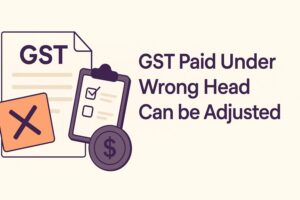How to Amend GSTR-1 After Filing B2B Invoices: A Step-by-Step Guide
- 13 Aug 24
- 12 mins

How to Amend GSTR-1 After Filing B2B Invoices: A Step-by-Step Guide
Key Takeaways
- GSTR-1 reports monthly or quarterly outward supplies, essential for GST compliance in India.
- Filing GSTR-1 accurately and timely is mandatory to avoid penalties and enable ITC for buyers.
- Amendments in GSTR-1 should consider deadlines, documentation, and impact on ITC.
- Changes affect buyers' ITC and require precise corrections to supplier details.
- Amendments impact tax liability and ITC eligibility; accuracy minimizes legal risks.
Navigating the Goods and Services Tax (GST) system in India can be a complex process, especially when it comes to amending already-filed returns. This guide will walk you through the process of amending B2B invoice details in your GSTR-1 after filing, ensuring that your business stays compliant while correcting any errors.
What is GSTR-1 in India?
Registered businesses in India must submit GSTR-1, a monthly or quarterly return, to report the specifics of their outward supplies of goods and services. This return is a crucial component of the Goods and Services Tax (GST) system, which was implemented in India on July 1, 2017, to unify the country's complex tax structure into a single, streamlined system.
The purpose of GSTR-1 is to provide the GST authorities with detailed information about the sales of a business, including the taxable value of supplies, applicable tax rates, and the amount of GST collected on sales. It serves several key functions:
- Transparency and Compliance: It ensures transparency in the taxation system and helps in compliance with GST regulations.
- Input Tax Credit: It enables the recipients of the goods or services (buyers) to claim input tax credit (ITC). The recipient's GSTR-2A and GSTR-2B, which are essential for them to claim ITC, are auto-populated with the information the supplier provides in GSTR-1.
- Taxation Process: It aids in the calculation of tax liabilities.
- Reconciliation: By comparing the data provided by the suppliers with that of the recipients, it makes it easier to reconcile sales and purchases through the GSTN portal.
Filing GSTR-1 is mandatory for all registered businesses except for those opting for the GST Composition Scheme (who must file GSTR-4) and those with a turnover below a specified threshold who can opt for the GST QRMP (Quarterly Return Monthly Payment) Scheme. The due date for filing GSTR-1 varies depending on the turnover and chosen filing frequency of the business (monthly or quarterly filing).
Non-filing or late filing of GSTR-1 attracts penalties and affects the recipients' ability to claim ITC, emphasizing the importance of timely and accurate return submission under the GST framework.
Preparing for Amendment: What to Know Beforehand

Before proceeding with the amendment of GSTR-1 for B2B invoices, it's critical to be well-prepared and informed about the process, regulations, and potential implications.
This preparation ensures that the amendments are accurate, compliant, and minimize any adverse effects on your GST liabilities or your buyers' input tax credit (ITC). Here's what you need to know beforehand:
What can be amended?
Not all fields in a submitted GSTR-1 can be amended. Familiarize yourself with which details can be changed, such as invoice values, GST rates, or recipient details, and understand the limitations on amendments.
Know the Amendment Deadlines
Amendments must be made within a specific timeframe. Generally, you can amend GSTR-1 of a particular tax period until the due date of the return for the month of September following the end of the financial year in which such supply was made, or the actual date of filing of the relevant annual return, whichever is earlier.
Missing these deadlines can result in the inability to make necessary corrections.
- Impact on Input Tax Credit (ITC)
Amendments in GSTR-1 can affect the ITC available to your buyers. Any changes you make will reflect in their GSTR-2A and GSTR-2B, impacting their credit claims. It's important to communicate with affected parties to ensure they are aware of the amendments and can adjust their credit claims accordingly.
- Documentation and Record-Keeping
Maintain comprehensive records and documentation supporting the need for amendments, including original and revised invoices, correspondence with buyers, and internal approval documents. These records may be required for verification by tax authorities or to resolve disputes with buyers regarding ITC claims.
- System Limitations
Familiarize yourself with the technical aspects and limitations of the GST portal, including how to navigate through the amendment sections, the bulk amendment option, if available, and understanding error messages that may arise during the process.
- Legal Implications
Understand the legal implications of making amendments, including any potential penalties for incorrect reporting, both before and after amendments. It's crucial to ensure that all changes are compliant with GST laws and regulations.
- Consult with Experts
Considering the complexity of GST regulations and the potential financial implications of amending returns, consulting with a GST expert or tax advisor before making any amendments is advisable. They can provide guidance tailored to your specific situation, ensuring compliance and minimizing risks.
Step-by-Step Guide to Amend GSTR-1
Amending GSTR-1 is an essential process for correcting any mistakes in the initially filed return. Whether it's an error in invoice details, the GSTIN of the buyer, or the taxable value, the GST system allows for these corrections through amendments in the subsequent period's GSTR-1 filing.
Here's a step-by-step guide to help you navigate through the amendment process:
Step 1: Log in to the GST Portal
- Start by visiting the official GST portal (gst.gov.in).
- Enter your username and password to log in to your account.
Step 2: Navigate to the Return Dashboard
- Once logged in, go to the 'Services' menu, select 'Returns', and then click on 'Returns Dashboard'.
- Choose the financial year and return filing period (month) for which you want to make the amendment.
Step 3: Select the GSTR-1 Form
On the Returns Dashboard, you'll find the list of returns. Click on the 'Prepare Online' option under GSTR-1.
Step 4: Choose the Section to Amend
GSTR-1 consists of various sections based on the type of outward supplies made. Select the section where amendments are needed. For B2B amendments, choose the section related to B2B invoices.
Step 5: Editing Details
- After selecting the appropriate section, the portal will display the invoices filed in the original return.
- Click on the 'Amend' button next to the invoice details that require correction.
- Make the necessary changes, such as correcting the GSTIN of the buyer, invoice number, date, taxable value, or tax amount.
Step 6: Adding Missing Invoices (if any)
If you've missed adding any invoices in the original return, you can add them in the section for amendments. Ensure that all details are accurate to avoid future discrepancies.
Step 7: Save the Amendments
After making the necessary corrections or additions, click on the 'Save' button to store the changes. The system will validate the changes and may prompt if there are any errors.
Step 8: Preview and Submit
It's important to review the amendments carefully. Use the 'Preview' feature to check the summary of amendments.
Once satisfied that all amendments are correct, proceed to submit the amended GSTR-1. You might be required to digitally sign the submission using an Electronic Verification Code (EVC) or a Digital Signature Certificate (DSC).
Step 9: Acknowledgement
After successful submission, the system will generate an acknowledgement. It's a good practice to save this acknowledgement for your records.
Points to Remember:
- Amendment Period: You can make amendments in the GSTR-1 of the month following the original invoice date. However, there are deadlines post which amendments cannot be made, so keep an eye on the due dates.
- Impact on Recipients: Remember, amending invoices in GSTR-1 will affect the input tax credit (ITC) of the recipients. They will also need to accept these amendments for the changes to reflect in their GSTR-2A and GSTR-2B.
- Accuracy: Ensure that the details entered during the amendment are accurate. Repeated amendments can raise red flags and might lead to scrutiny by the tax authorities.
The Impact of Amendments on GST Returns

The process of amending GSTR-1, which involves modifying previously filed returns to correct errors or omissions, can have significant impacts on both the filer's and their customers' GST returns.
Understanding these impacts is crucial for maintaining compliance and ensuring the accuracy of tax liabilities and input tax credits. Here’s how amendments in GSTR-1 affect GST returns:
- Immediate Impact on Input Tax Credit (ITC)
Adjustments in ITC for Buyers: Any amendment made in the GSTR-1 by a supplier for B2B transactions directly affects the eligibility and amount of Input Tax Credit (ITC) available to the buyers. Corrections in invoice details, tax amounts, or taxable values will alter the ITC that buyers can claim on their purchases. These changes are reflected in the buyers' GSTR-2A and GSTR-2B, which are auto-populated based on the supplier's GSTR-1.
Reconciliation Challenges: Amendments may lead to discrepancies in the GSTR-2A and GSTR-3B of the buyers, requiring them to undertake a thorough reconciliation process. This is essential to ensure the ITC claimed matches the revised details provided by their suppliers.
- Impact on Tax Liability
Rectification of Under-reported Sales: If the amendment involves declaring previously under-reported sales, it will result in an increased tax liability for the period in which the original sales invoice was issued. The supplier will need to pay the additional tax along with any applicable interest or penalties.
Correction of Over-reported Sales: Conversely, if sales were over-reported, amending the return to correct this error may decrease the supplier's tax liability. Any excess tax paid due to the original mistake can be adjusted against future tax liabilities or claimed as a refund, subject to GST regulations.
- Long-term Implications
Compliance Rating: Regular amendments, especially if they are significant and frequent, could affect the perceived compliance rating of a business within the GST system. A lower compliance rating could lead to increased scrutiny from tax authorities and may impact the business relationship with certain customers who might rely on the compliance status of their suppliers for smooth ITC claims.
- Audit and Legal Implications
Frequent amendments might raise red flags, potentially leading to audits by tax authorities. Ensuring that amendments are done carefully and accurately is important to avoid legal complications or scrutiny.
- Operational Efficiencies
Efficiently managing amendments in GSTR-1 can lead to improved operational efficiencies. By regularly reviewing and correcting discrepancies, businesses can ensure smoother tax processes, better financial reporting, and improved relations with business partners.
Conclusion
GSTR-1 filings must include a process for converting B2C to B2B transactions in order to ensure GST compliance and optimize financial health in India's tax environment. The rectification of errors that were present in the initial filings through these amendments serves to facilitate the proper flow of input tax credits and maintain the integrity of the GST framework.

By requiring businesses to enroll in and submit corrections via the GST portal, the amendment procedure is designed to facilitate compliance responsibilities.
In addition to rectifying entries, these amendments are crucial for preserving a favorable conformance rating, preventing legal complications, and ensuring operational effectiveness. They promote improved business relationships and facilitate accurate financial reporting by ensuring that ITC claims for recipients are processed efficiently.
In short, efficiently managing GSTR-1 amendments is essential for staying compliant within the GST framework, supporting smooth business operations, and upholding accurate financial practices
💡That’s why utilizing Pice application can ensure all your important business payments, like supplier/vendor payments, rent, GST, & utility, run smoothly and on time from one single dashboard. Book a 15-minute free demo to learn how we can help you manage all your business payments



















